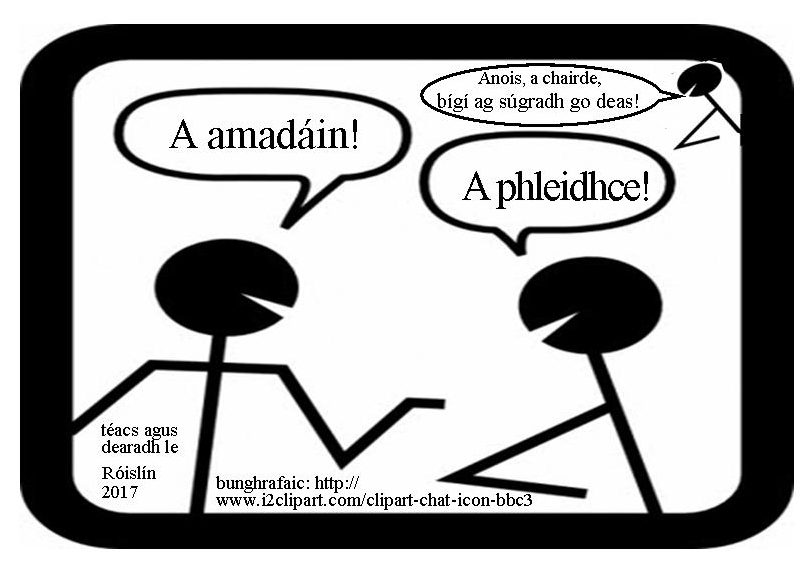Harry Potter agus an Órchloch: Sraith Ócáideach d’Fhocail Shuimiúla sa Leagan Gaeilge (Cuid 2: pleidhce nó amadán nó pleidhce amadáin?) Posted by róislín on Jan 19, 2017 in Irish Language
(le Róislín)
Which word would you pick to call someone a fool in Irish — amadán or pleidhce? Or would you opt for the double whammy — pleidhce amadáin? All of these appear in Harry Potter agus an Órchloch, the Irish translation by Máire Nic Mhaoláin, not too surprisingly since the kids are fairly fond of calling each other names, especially, sa leagan Béarla, “eejit.”
The Irish word “amadán” is probably the most widely used and the most widely taught of all ways to say “fool” i nGaeilge. It also shows up in Irish English, sometimes with gaelicized English spelling (amadaun, omadaun, omadhaun, omadawn, and ommadawn, the latter as in the Mike Oldfield album); more on these sa chéad bhlagmhír eile.
This word also gives us a lot of spin-offs, such as amadántacht, foolishness, amaideach, foolish, and amaidí, folly, nonsense.
In the interests of Equal Opportunity vocabulary for hurling insults at one another, I should mention that “amadán” most basically refers to a male fool, with “amaid” being used for a woman and a completely different word, “óinseach,” for a female fool. Further investigation of this topic will surely be a tionscadal lá na coise tinne (an Irish phrase equivalent to but not a translation of “rainy day project”).
Here are some of the basic forms for “amadán“:
an t-amadán, the fool
an amadáin, of the fool (suíochán taobh cnoic an amadáin, the hillside seat of the fool, referring to the fool on the hill of Beatles’ song fame)
na hamadáin, the fools
na n-amadán, of the fools (Lá na nAmadán, the Day of the Fools, i.e. April Fools’ Day, with the slight adjustment for capitalization)
In the graphic above, you may notice that the first character calls the second one “amadáin” (with an “i”), since it’s in direct address
Another typical word for “fool” is “pleidhce,” which also shows up several times in Harry Potter, including in “Tríd an gComhla Síos” (Caibidil 16), when Ron tells Neville not to be “i do phleidhce amadáin” and Neville tells Ron not to call him a “pleidhce.” This word also has some spin-offs, including pleidhcíocht (tomfoolery) and pleidhciúil (silly, foolish). Here are some of its basic forms:
an pleidhce [un PLY-kyuh, that’s “ply” as in “plywood”], the fool
an phleidhce [un FLY-kyuh, that’s “fly” as in “to fly”], of the fool (pleidhcíocht phleidhciúil an phleidhce, the foolish tomfoolery of the fool)
na pleidhcí, the fools
na bpleidhcí, of the fools (bladhmann na bpleidhcí, the boasting of the fools)
In direct address, one would say “A phleidhce!” if speaking to one person; same pronunciation as the “of the” form (uh FLY- kyuh). If addressing more than one person, it would be “A phleidhcí!” That’s what Gandalf could have said to the rest of the party crossing “Droichead Khazad-dûm” — Teithigí, a phleidhcí! That would mean “Fly, you fools!,” or more literally, “Flee, you fools!” Actually saying “Fly” would be “Eitlígí” and it really would imply flying with wings!
And what’s the double whammy version of all this? Seo é:
pleidhce amadáin, a silly fool, lit. a fool of a fool
Bhuel, that’s a few ways to say “fool” in Irish. There are more, which we’ll discuss closer to Lá na nAmadán. You might also want to check out a previous blogpost on the topic (nasc thíos). Meanwhile, remember that for every aspersion you cast, you’re likely to receive one back. But, hey, it’s all in the name of learning Irish, especially for practicing an tuiseal gairmeach (the vocative case), which is the form for direct address. Slán go fool, úúps, go fóill — Róislín :
Nasc: Lá na nAmadán…na nGamal?…na nÓinseach?…na bPleidhcí?…na bPleotaí? Posted by róislín on Mar 30, 2012 in Irish Language

Build vocabulary, practice pronunciation, and more with Transparent Language Online. Available anytime, anywhere, on any device.





Leave a comment: